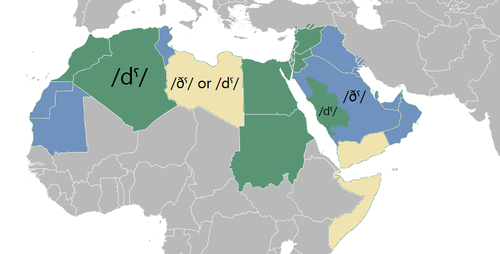Ḍād
| Ḍād | |
|---|---|
| Arabic | ﺽ |
| Phonemic representation | d̪ˤ~dˤ,d̪ˠ |
| Position in alphabet | 26 |
| Numerical value | 800 |
| Alphabetic derivatives of the Phoenician | |
| Ḍād | |
|---|---|
| ﺽ | |
| Usage | |
| Writing system | Arabic script |
| Type | Abjad |
| Language of origin | Arabic language |
| Sound values | d̪ˤ~dˤ,d̪ˠ |
| Alphabetical position | 15 |
| History | |
| Development |
|
| Other | |
| Writing direction | Right-to-left |
Ḍād(ﺽ) is one of the six letters theArabic alphabetadded to the twenty-two inherited from thePhoenician alphabet(the others beingṯāʾ,ḫāʾ,ḏāl,ẓāʾ,ġayn). In name and shape, it is a variant ofṣād. Its numerical value is 800 (seeAbjad numerals).
In Modern Standard Arabic and many dialects, it represents an "emphatic"/d/,and it might be pronounced as apharyngealizedvoiced alveolar stop,pharyngealized voiced dental stop[d̪ˤ]orvelarizedvoiced dental stop[d̪ˠ].[1]The sound it represented at the time of the introduction of the Arabic alphabet is somewhat uncertain, likely apharyngealizedvoiced alveolar lateral fricativeor a similaraffricatedsound[d͡ɮˤ]or[dˡˤ].[2]One of the important aspects in someTihamadialects is the preservation of the emphatic lateral fricative sound[ɮˤ],this sound is likely to be very similar to the original realization of ḍād, but this sound ([ɮˤ]) and[ðˤ]are used as two allophones for the two sounds ḍādضand ẓāʾظ.[3]
| Position in word | Isolated | Final | Medial | Initial |
|---|---|---|---|---|
| Glyph form: (Help) |
ض | ـض | ـضـ | ضـ |
Origin
[edit]Based on ancient descriptions of this sound, it is clear that inQur'anic Arabicḍwas some sort of unusuallateralsound.[1][2][4][5][6]Sibawayh,author of the first book onArabic grammar,explained the letter as being articulated from "between the first part of the side of the tongue and the adjoiningmolars".It is reconstructed by modern linguists as having been either apharyngealizedvoiced alveolar lateral fricativeor a similaraffricatedsound[d͡ɮˤ]or[dˡˤ].[2][4]The affricated form is suggested by loans ofḍinto Akkadian asldorlṭand into Malaysian asdl.[1]However, not all linguists agree on this; the French orientalist André Roman supposes that the letter was actually a voiced emphatic alveolo-palatal sibilant/ʑˤ/,similar to the Polishź.[2][4][7]
This is an extremely unusual sound, and led the early Arabic grammarians to describe Arabic as theلغة الضادlughat aḍ-ḍād"the language of theḍād",since the sound was thought to be unique to Arabic.[1]
The emphatic lateral nature of this sound is possibly inherited fromProto-Semitic,and is compared to a phoneme inSouth Semiticlanguages such asSoqotri,but also inMehriwhere it is usually anejectivelateral fricative.
The corresponding letter in theSouth Arabian alphabetisṣ́,and in theGeʽez scriptṢ́appaፀ), although inGeʽezit merged early on withṣ.
The reconstruction ofProto-Semiticphonology includes an emphaticvoiceless alveolar lateral fricative[ɬʼ]oraffricate[t͡ɬʼ]forṣ́.This sound is considered to be the direct ancestor of Arabicḍād,while merging withṣādin most otherSemitic languages.
The letter itself is distinguished a derivation, by addition of adiacritic dot,fromصṣād(representing /sˤ/).
Pronunciation
[edit]
The standard pronunciation of this letter inModern Standard Arabicis the "emphatic"/d/:pharyngealizedvoiced alveolar stop,pharyngealized voiced dental stop[d̪ˤ]orvelarizedvoiced dental stop[d̪ˠ].[1]
In most Bedouin influenced Arabic vernacularsضḍādandظẓāʾmerged quite early;[2]in the varieties where the dental fricatives are preserved such asBedouin ArabicandMesopotamian Arabic,both the letters are pronounced/ðˤ/.[2][4][6]However, there are dialects in South Arabia and inMauritaniaand theSahrawiwhere both the letters are kept different but not in all contexts.[2]In other vernaculars such as Egyptianضḍādandظẓāʾcontrast; but Classical Arabicẓāʾbecomes/zˤ/,e.g.ʿaẓīm[ʕɑˈzˤiːm](< Classicalعظيمʿaḏ̣īm[ʕɑˈðˤiːm]) "great".[2][4][8]
"De-emphaticized" pronunciation of both letters in the form of the plain/z/entered into other non-Semitic languages such as Persian, Urdu, and Turkish.[2]However, there do exist Arabic borrowings intoIbero-Romance languagesas well as Hausa and Malay, whereḍādandẓāʾare differentiated.[2]
Transliteration
[edit]ضis transliterated asḍ(Dwithunderdot) inromanization.The combination ⟨dh⟩ is also sometimes used colloquially. In varieties where the Ḍād has merged with theẒāʾ,the symbol for the latter might be used for both (eg. ⟨ظل⟩ 'to stay' and ⟨ضل⟩ 'to be lost' may both be transcribed asḏ̣alinGulf Arabic).
When transliterating Arabic in the Hebrew alphabet, it is either written asד (the letter for/d/) or asצ׳(tsadiwithgeresh), which is also used to represent the /tʃ/ sound. The Arabic lettersṣādصandḍādضshare the sameSemiticorigin with the Hebrewtsadi.
InJudeo-Arabic orthography,it has been written asצׄ/ץׄ(tsadewithholam), emulating Arabic orthography, where the letter is created by adding a dot toṣādص.
Unicode
[edit]| Preview | ض | |
|---|---|---|
| Unicode name | ARABIC LETTER DAD | |
| Encodings | decimal | hex |
| Unicode | 1590 | U+0636 |
| UTF-8 | 216 182 | D8 B6 |
| Numeric character reference | ض |
ض |
See also
[edit]References
[edit]- ^abcdeVersteegh, Kees (2003) [1997].The Arabic language(Repr. ed.). Edinburgh: Edinburgh University Press. p. 89.ISBN9780748614363.
- ^abcdefghijVersteegh, Kees (1999)."Loanwords from Arabic and the merger of ḍ/ḏ̣".In Arazi, Albert; Sadan, Joseph; Wasserstein, David J. (eds.).Compilation and Creation in Adab and Luġa: Studies in Memory of Naphtali Kinberg (1948–1997).pp. 273–286.ISBN9781575060453.
- ^Alqahtani, Khairiah (June 2015).A sociolinguistic study of the Tihami Qahtani dialect in Asir, Southern Arabia(PDF)(PhD thesis). University of Essex. pp. 45, 46.
- ^abcdeVersteegh, Kees (2000)."Treatise on the pronunciation of theḍād".In Kinberg, Leah; Versteegh, Kees (eds.).Studies in the Linguistic Structure of Classical Arabic.Brill. pp. 197–199.ISBN9004117652.
- ^Ferguson, Charles (1959). "The Arabic koine".Language.35(4): 630.doi:10.2307/410601.JSTOR410601.
- ^abFerguson, Charles Albert (1997) [1959]."The Arabic koine".In Belnap, R. Kirk; Haeri, Niloofar (eds.).Structuralist studies in Arabic linguistics: Charles A. Ferguson's papers, 1954–1994.Brill. pp. 67–68.ISBN9004105115.
- ^Roman, André (1983).Étude de la phonologie et de la morphologie de la koiné arabe.Vol. 1. Aix-en-Provence: Université de Provence. pp. 162–206.
- ^Retsö, Jan (2012)."Classical Arabic".In Weninger, Stefan (ed.).The Semitic Languages: An International Handbook.Walter de Gruyter. pp. 785–786.ISBN978-3-11-025158-6.
